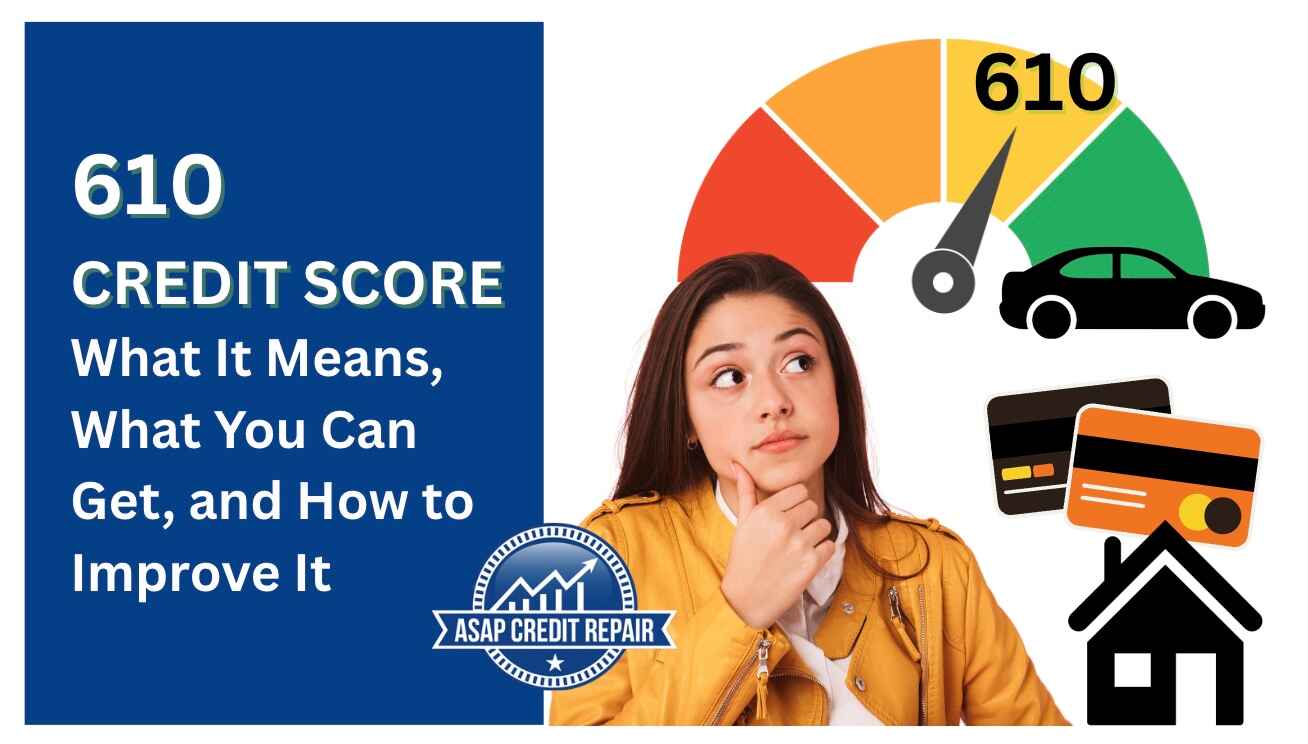610 credit score. That was the number staring back at Sarah when she finally opened her credit report. She had put it off for months, worried about what she might find. Now that she saw it, she didn’t know whether to panic or shrug.
“Is 610 a good credit score? Can I still buy a house? Get a credit card? What does this even mean?”
If you're like Sarah and wondering about your 610 credit score, you're not alone. Millions of Americans have credit scores in this range, and understanding what it means can help you make better financial decisions moving forward.
In this article, we’ll break down what a 610 credit score really means, what you can qualify for, and how to raise it.
Disclaimer: This article is for informational purposes only. Always consult with a certified financial advisor or credit expert regarding your specific situation.
Is a 610 Credit Score Good or Bad?
A 610 credit score falls within the "fair" credit range. On the FICO scale, which runs from 300 to 850, scores between 580 and 669 are considered fair. Your score of 610 sits right in this category.
According to Experian, one of the three major credit bureaus, approximately 17% of Americans have a credit score in the fair range. This means your 610 credit score is better than what about 16% of consumers have, but there's definitely room for improvement.
To put it simply:
- Excellent: 800-850
- Very Good: 740-799
- Good: 670-739
- Fair: 580-669 (your 610 score falls here)
- Poor: 300-579
Astrid, a financial advisor at ASAP Credit Repair, explains: "A 610 credit score isn't terrible, but it's like being a C student. You're passing, but you won't have access to the best financial opportunities out there."
Good Read: Does the Method for Calculating Credit Scores Seem Fair to You? Why or Why Not?
What Can I Get With a 610 Credit Score?
Credit Cards for a 610 Credit Score
With a 610 credit score, you can qualify for several credit cards, though not necessarily those with the best terms or rewards.
Capital One's QuicksilverOne and Discover it® Secured are two popular options for people with fair credit. The Discover card with a 610 credit score can be particularly helpful because Discover has a pre-approval tool that won't affect your credit score.
Jessica Zhang, a credit card analyst, shares: "Many people with a 610 credit score find success with credit cards designed for fair credit. These cards often have annual fees between $0-$99 and APRs starting around 23.99%, which is higher than what those with excellent credit would pay."
According to a 2024 Credit Card Insider survey, about 65% of applicants with scores between 600-619 were approved for cards specifically marketed to fair credit consumers.
Can I Buy a House With a 610 Credit Score?
Yes, you can buy a house with a 610 credit score, but your options will be somewhat limited.
FHA loans are often the go-to choice for homebuyers with fair credit. The Federal Housing Administration requires a minimum score of 580, so your 610 credit score would qualify. However, you'll likely need to make a down payment of at least 3.5% of the home's purchase price.
Some VA loans and USDA loans might also be options if you meet their specific eligibility requirements beyond credit score.
Mark Thompson, a mortgage broker with 15 years of experience, notes: "I've helped many clients with a 610 credit score secure mortgages. The interest rates are typically 1-2 percentage points higher than for those with excellent credit, which can mean tens of thousands of dollars more over the life of a 30-year loan."
According to the Federal Reserve, the average mortgage rate difference between someone with a 610 score versus a 740 score could be around 1.5%, which on a $250,000 mortgage means paying about $225 more per month.
Let’s break it down:
🏠Mortgage (30 years, $250,000)
- 610 score: 7.5% interest → $1,748/month → $379,280 total interest
- 740 score: 6.0% interest → $1,499/month → $289,640 total interest
→ $89,640 savings
Auto Loans With a 610 Credit Score
Car loans are generally more accessible than mortgages for people with fair credit. With a 610 credit score, you can get approved for an auto loan, but expect:
- Higher interest rates (typically 7-15% versus 3-6% for excellent credit)
- Possibly higher down payment requirements
- Shorter loan term options
Carlos Menendez, an auto finance specialist, says: "I see customers with a 610 credit score get approved every day. The difference is they might pay $3,500 more in interest over a 5-year loan compared to someone with excellent credit."
Recent data from Experian's State of the Automotive Finance Market report indicates that borrowers with credit scores between 601-660 received average auto loan rates of about 9.5% for new cars and 14.3% for used cars.
Here’s a sample:
đźš— Auto Loan (5 years, $20,000)
- 610 score: 11.5% interest → $437/month → $6,220 interest total
- 700 credit score: 6.5% interest → $391/month → $3,460 interest
→ $2,760 savings
Components That Make Up Your 610 Credit Score
Understanding how your 610 credit score is calculated can help you improve it. Here are the five factors that influence your FICO score:
1. Payment History (35%)
Your track record of paying bills on time has the biggest impact on your score. With a 610 credit score, you likely have some late payments on your record.
Michael Roberts, who improved his score from 615 to 720 in nine months, shares: "I discovered I had three late payments from two years ago that were dragging my score down. Once I established a perfect payment record for six months, my score jumped 45 points."
According to FICO, a single 30-day late payment can drop your score by 80 points or more.
2. Credit Utilization (30%)
This measures how much of your available credit you're using. Most financial experts recommend keeping this under 30%, but ideally under 10%.
Someone with a 610 credit score typically has a utilization rate above 50%, according to data from Credit Karma.
Recommended Article: How Mastering Credit Utilization Can Boost Your Credit Score
3. Length of Credit History (15%)
The longer your credit accounts have been open, the better. A 610 credit score might indicate a relatively short credit history or a mix of older and newer accounts.
4. Credit Mix (10%)
Having different types of credit (credit cards, loans, mortgages) shows you can handle various financial responsibilities.
5. New Credit (10%)
Opening several new accounts in a short period can lower your score temporarily.
Real Experiences of People With a 610 Credit Score
Maria Johnson, a teacher from Ohio, shares her experience: "With my 610 credit score, I was able to get a car loan, but the interest rate was 11.5%. My friend with a 750 score got 4.2% for the same car. That really opened my eyes to how much my fair credit was costing me."
David Chen, a recent college graduate, adds: "I was surprised that my 610 credit score qualified me for an apartment, but they required a larger security deposit than they would have for someone with better credit."
According to a survey by WalletHub, 67% of people with fair credit report experiencing some type of financial rejection or less favorable terms in the past year.
Related Story: Lisa’s Journey – How She Went from Poor Credit to Homeownership
How to Improve Your 610 Credit Score
The good news is that a 610 credit score can be improved relatively quickly with the right strategies:
1. Pay All Bills On Time
Set up automatic payments or reminders to avoid missing due dates. According to Equifax, consistent on-time payments can improve your score by 20-40 points within three months.
2. Reduce Credit Card Balances
Try to get your utilization below 30%. A Northwestern Mutual study found that reducing utilization from 70% to 30% resulted in an average 40-point score increase.
3. Don't Close Old Credit Cards
Keep your oldest accounts open to maintain your length of credit history.
4. Limit New Credit Applications
Each hard inquiry can drop your score by up to 10 points.
5. Check Your Credit Report for Errors
About 25% of credit reports contain errors that could be lowering your score, according to a Federal Trade Commission study. You can get free reports from AnnualCreditReport.com.
6. Consider a Secured Credit Card
These require a deposit but can help build credit when used responsibly.
7. Become an Authorized User
If a family member with excellent credit adds you as an authorized user, their good credit history could help yours.
Eric De la Rosa, a credit counselor, shares: "I've seen clients with a 610 credit score reach 700+ in as little as 8-12 months by following these strategies consistently."
How Long Does It Take to Improve a 610 Credit Score?
Improvement timelines vary based on your specific credit situation:
- Short-term improvements (1-3 months): Reducing credit utilization can boost your score quickly.
- Medium-term improvements (3-6 months): Consistent on-time payments start showing significant effects.
- Long-term improvements (6+ months): Negative items like late payments have less impact as they age.
As we see here at ASAP Credit Repair, the average person with a fair credit score who focuses on improvement can see a 40-point increase within six months.
We have real stories on how we did it! Check out How Alex Boosted His 517 Credit Score & Secured a $100K Business Loan in 4 Months
Can You Get a 600 Credit Score?
Yes, you can have a credit score of 600, which is slightly lower than a 610 credit score. Both fall in the "fair" credit range. Scores can fluctuate based on recent credit activity.
The Financial Impact of Improving Your 610 Credit Score
Consider this practical example:
On a $20,000, 5-year auto loan:
- With a 610 credit score: 11.5% interest rate = $437/month and $6,220 total interest
- With a 700 credit score: 6.5% interest rate = $391/month and $3,460 total interest
That's a savings of $2,760 just by improving your score!
Similarly, on a $250,000, 30-year mortgage:
- With a 610 credit score: 7.5% interest rate = $1,748/month and $379,280 total interest
- With a 740 credit score: 6.0% interest rate = $1,499/month and $289,640 total interest
The difference? A staggering $89,640 saved over the life of the loan!
Conclusion: Your 610 Credit Score Journey
A 610 credit score puts you in a fair position - not ideal, but definitely workable. With consistent effort and smart financial habits, you can improve this score over time.
Remember Sarah from the beginning of our story? Six months after discovering her 610 credit score, she had paid down her credit card balances, set up automatic payments, and disputed two errors on her credit report. Her score jumped to 665, qualifying her for better interest rates and more financial opportunities.
Your credit journey is just that - a journey. A 610 credit score is simply your starting point, not your destination. With patience and persistence, you can work toward a brighter financial future with more options and less stress.
Are you ready to take the first step toward improving your 610 credit score today? Work with ASAP Credit Repair now and get the credit score of your dreams!

